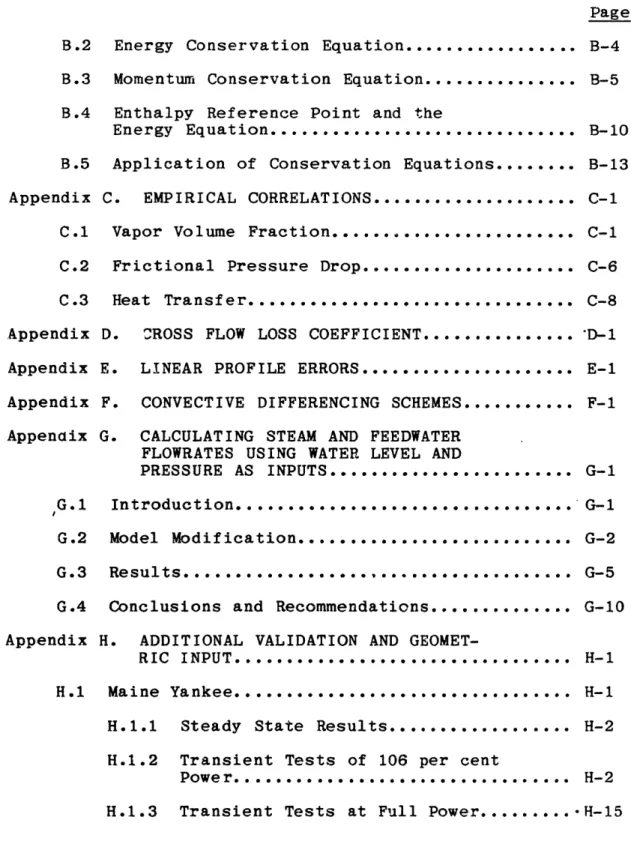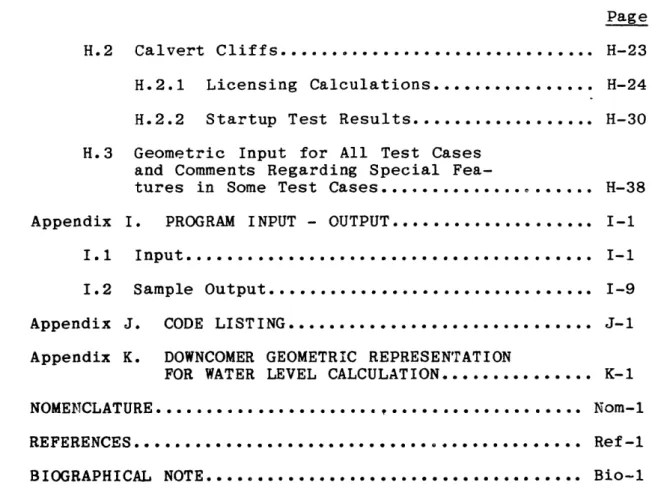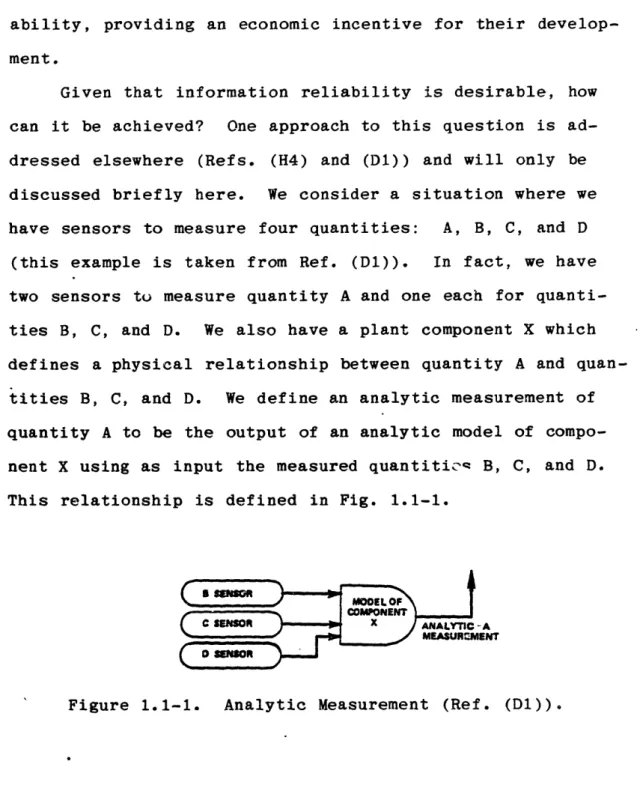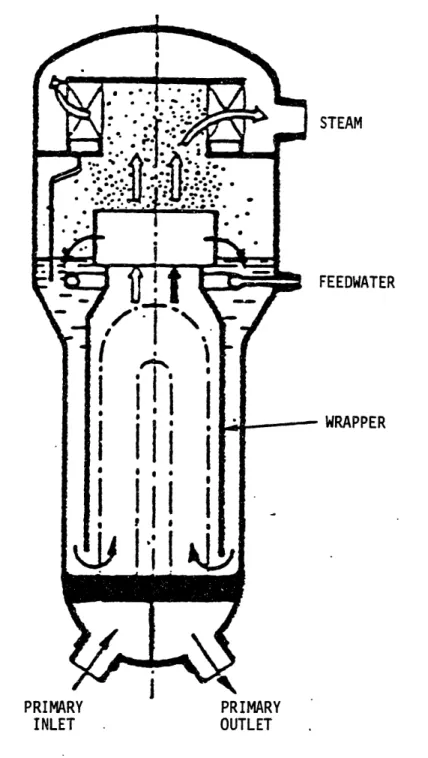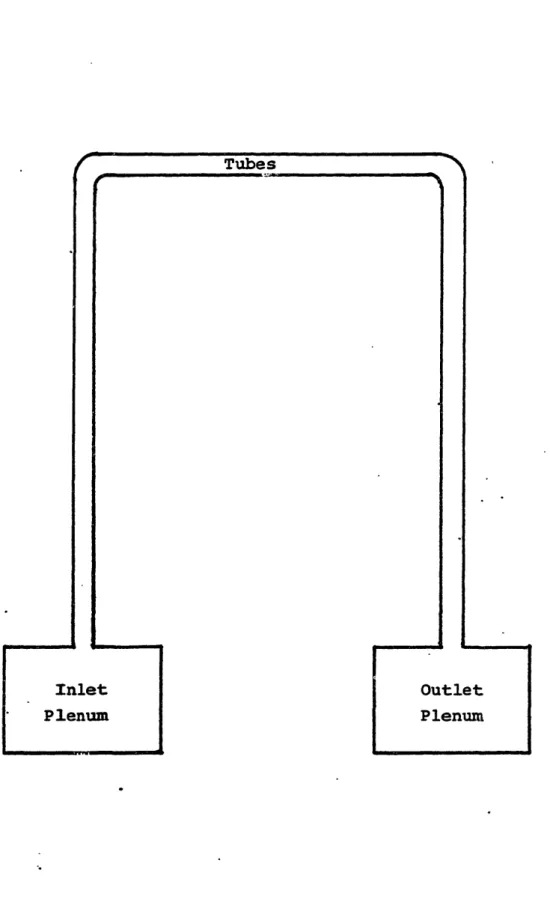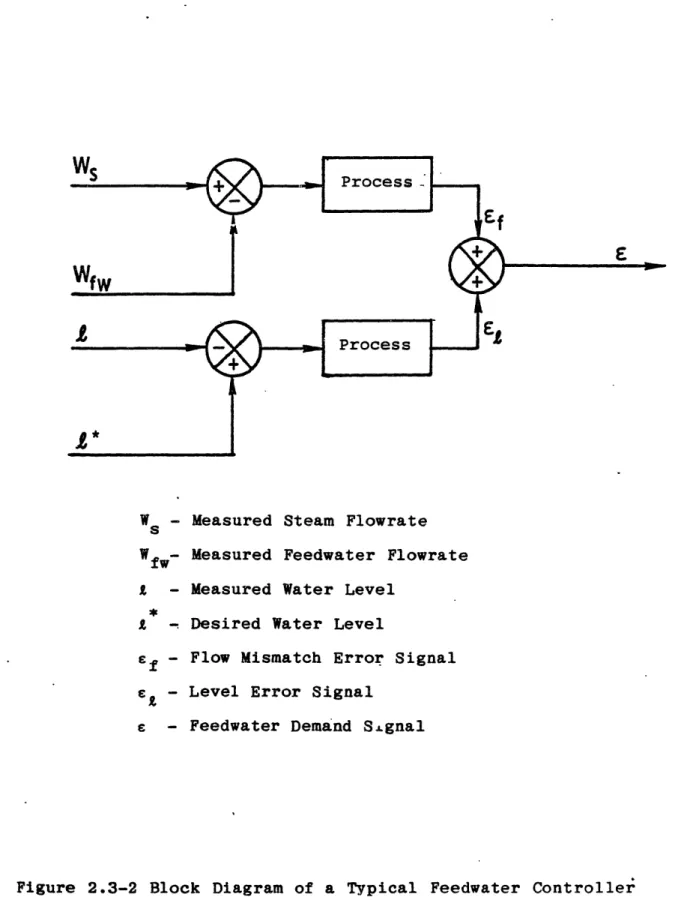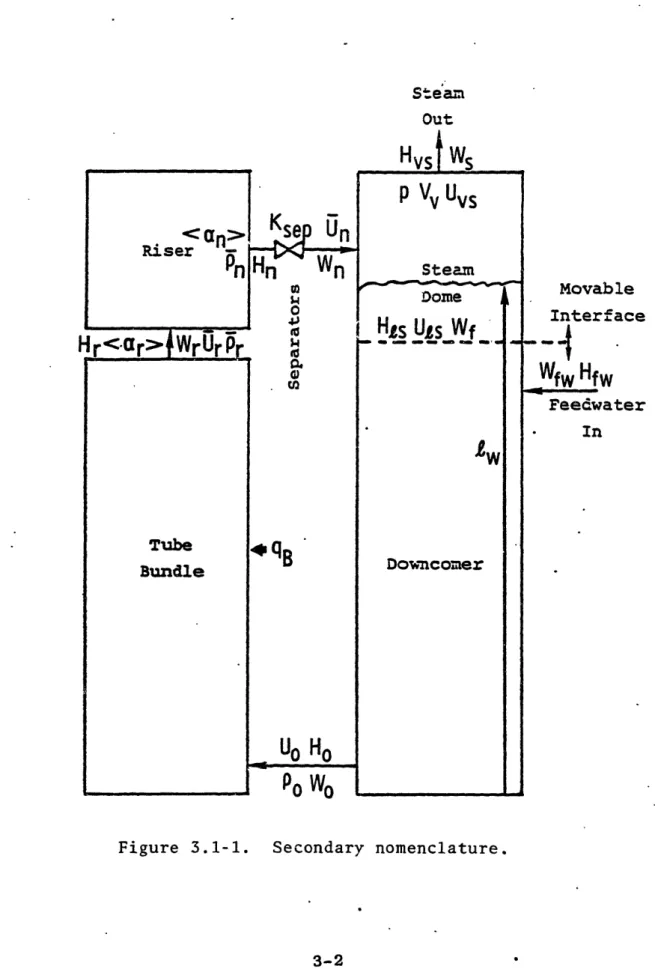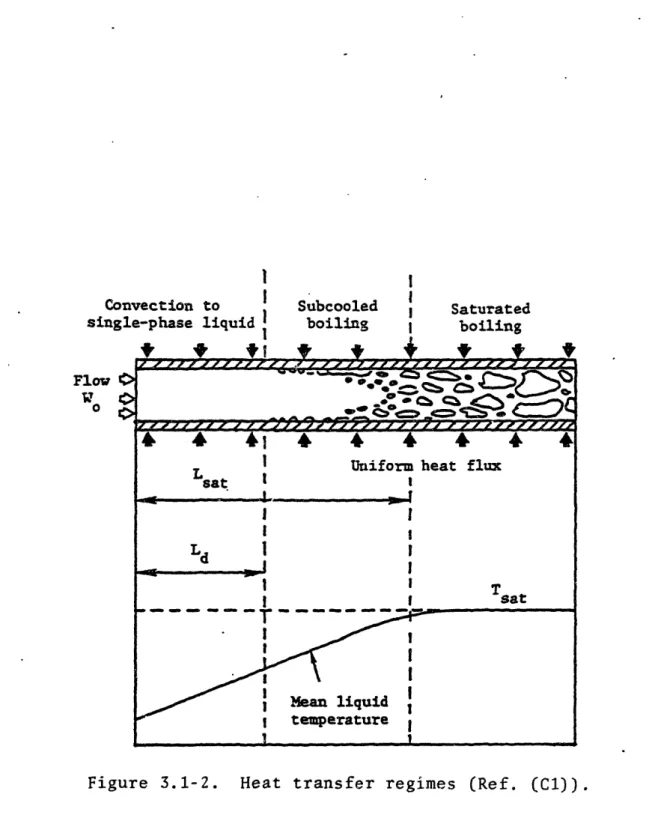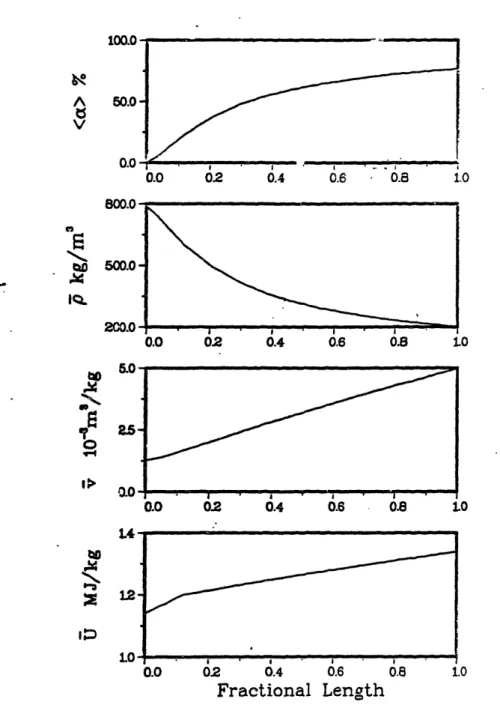DYNAMIC MOI).ELING OF VEFRTICAl. U-TUIEI STEAM GENERIATO RS IOR OPERIAIONAL, SAFETI SYSTETMS
(Voi 11)
by
WALTF.R HERBERT ST'ROHMAYER
B. S. Rensselaer Polytechnic Institute
(Dec. 1976)
S. M. MNIassachlusetts
Institute of Technology
(JLune1978)
S UBMI ITI) TO T1 ll DI)'.PARTMr,.N'I' OF NUCI.lFAIR FNG1NFF'RING IN P.ARTIAL
FUuI.I.l.Ml'N' O 'TIlE RI:QUIR'MEN1I S FOR TIlE
I).GREE OF1 DOcTOR Oit PHIIosoPttY
at the
MASSACHIUSLETS I NSTII 'UI' OF TciCI tNOILOGY
August 1982
© Walter Herbert Strolimayer 1982
Signature of Author
Department ot'N
luclear Engineering
AuLgust 1982
Certified by_
'rofessor John E. Meyer
hesis SupervisorAccepted by
-
rroressor Allan F. Henry
Chainnan, Departmental Graduate Committee
DYNAMIC MODELING OF VERTICAL U-TUBE STEAM GENERATORS FOR OPERATIONAL SAFETY SYSTEMS
by
Walter Herbert Strohmayer
Submitted to the Department of Nuclear Engineering on August 25, 1982. in partial fulfillment of the requirements for the degree of Doctor of Philosophy
in Nuclear Engineering.
ABSTRACT
Currently envisioned operational safety systems require fast running computer models of major power plant components in order to generate reliable estimates of significant
safety-related parameters. The objectives of this research are to develop and to validate such a model for a vertical U-tube natural circulation steam generator.
The model is developed using a first principles appli-cation of the one-dimensional conservation equations of mass, momentum, and energy. Two-phase flow is treated by using the drift flux model. Two salient features of the model are the incorporation of an integrated secondary-recirculation-loop momentum equation and the retention of all nonlinear effects. The inclusion of the integrated loop momentum equation permits calculation of the steam generator water level. The use of a nonlinear model, as opposed to a linearized model, allows accurate calculation of steam gen-erator conditions for transients with large changes from nominal operating conditions.
The model is validated over a wide range of steady-state conditions and a spectrum of transient tests ranging from turbine trip events to a milder full-length control-element assembly drop transient. The results of the valida-tion effort are encouraging, demonstrating that the model is suitable for application to a broad range- of operational transients.
Execution speed of the model appears to be fast enough to achieve real-time execution on plant process computers. Real Time-to-CPU Time ratios for running the computer pro-gram on an Amdahl 470 V/8 computer range from 47 to 200, with integration time step sizes of 0.1 to 0.4 seconds, respectively. When the model is run on a Digital Equipment Corp. VAX 11/780 computer using an integration time step of 0.25 seconds, the Real Time-to-CPU Time ratio is 11.
Thesis Supervisor: John E. Meyer
Title: Professor of Nuclear Engineering
Thesis Reader: David D. Lanning
ACKNOWLEDGMENTS
I would like to express my heartfelt appreciation to my
thesis supervisor, Professor John E. Meyer, for his
inval-uable support, advice, and assistance. His willingness to discuss, at any time, topics related to this project has
made my association with him a privileged and rewarding
experience.
Thanks are also due to Professor David D. Lanning who served as the reader of this thesis and motivated the
ad-vanced control systems group.
I wish to express my gratitude to Professor Allan F. Henry for his encouragement throughout my stay at M.I.T.
The work was funded through the fellowship program t
The Charles Stark Draper Laboratory. This allowed me to work with a group of professionals who truly enriched my own
professional development. I wish to acknowledge: Dr. John
Hopps, for his support and advice; Mr. James Deckert for his
valuable comments, help, and advice during the research;
Dr. Jay Fisher, for his support and thoughtful suggestions,
particularly during the validation phase of the study; Dr.
Asok Ray, whose technical expertise and willingness to share his knowledge contributed in no small way to my education;
and, Mr. Renato Ornedo, for his advice, constructive
The RD-12 boiler data was acquired through the courtesy
of Mr. C.G. Mewdell of Ontario Hydro, and Mr. W.C. Harrison
of the Whiteshell Nuclear Research Establishment.
Thanks are due to:
· Jon, Bob, Patrick, Ed, Jim, Dale, Mike, and Lucy, my
officemates, for their friendship and moral support; · Derek Ebeling-Koning, for his friendship;
· Peggy Conley, for her help;
· Jean Nolley, who made the bad times good;
· Edward Carbrey and his staff, for their help in the preparation of this thesis;
· Kathleen Rogness, who typed the majority of this thesis and did so with a cheerfulness and zeal that,
despite my constant revisions, was truly
appre-ciated; and,
· Lisa Kern, for typing various figures, and Laura
Burkhardt, for typing various figures and some of
the text, and Vugraphs.
This thesis is dedicated to my parents for their love,
support and encouragement.
Finally, thanks are due to Dr. P. Bergeron of Yankee
Atomic Co. for providing information related to the Maine
Yankee plant.
The information contained in this thesis cited as
de-riving from "Maine Yankee", however, should not be
consid-ered as representing that actual system in its current or projected operating configuration, but as an idealization
thereof. In particular, the results so identified in this
report have not been either reviewed or approved by the
Yankee organization.
I hereby assign my copyright of this thesis to The Charles Stark Draper Laboratory, Inc., Cambridge,
Massachusetts.
WlAter Herbert Strohmayer
Permission is hereby granted by The Charles
Stark Draper Laboratory, Inc. to the Massachusetts
Institute of Technology to reproduce any or all of
TABLE OF CONTENTS
Abstract
...
Page ii Acknowledgements ... List of Figures... List of Tables ... ... iii...
xii
... Xix ah r4- ", I TTD 'nTT" T' M %, lJl 6C Y 11zU.L -L. 1.1 1.2 1.3 1.4 Chapter 2.12.2
2.3Chapter
2. 3. 3.1 .Jki n I .IJ U .t X %JLL . . .. . .. . .. .. .. . . .. .. . .. . . . ..Background and Motivation
...
Research Objectives
...
Previous Work ... ...
Organization of Report ...
STEAM GENERATOR MODEL: OVERVIEW ...
Description of Steam Generator
...
Model Regions...
Auxiliary Models ...
SECONDARY SIDE MODEL...
Tube Bundle Region... ...
3.1.1 Mass and Energy Equations ...
3.1.2 Integration by Profiles ... 3.1.3 3.1.4 3.1.5 3.1.6 Detailed Profiles ... ... Approximate Profiles ...
Approximation Errors
..
...
State Variables ...
1-1
1-1
1-5
1-71-9
2-1 2-1 2-1 2-8 3-1 3-1 3-1 3-4 3-5 3-12 3-17 3-21 ···· · · · · · . . . . . . . .TABLE OF CONTENTS (Cont.)
3.2 Riser Region
...
...
3.2.1 Mass and Energy Equations...
3.2.2 Profiles
...
...
3.2.3 State Variables ...
3.3 Steam Dome and Downcomer ...
3.3.1 Case 1 Conservation Equations... 3.3.2 Case 1 State Variables ...
3.3.3 Case 2 Conservation Equations ... 3.3.4 Case 2 State Variables ...
3.4 Momentum Equation for the
Recircu-lating Flow ... ...
3.5 Closure of Equations...-3.6 Main Steam and Feedwater
Models...
3.7 Discussion of Model...
Chapter 4. PRIMARY SIDE MODEL....
4.1 Primary Fluid System....
4.1.1 Plenum Model...
4.1.2 Tubeside Model...
4.2 Heat Transfer Model...
System
· . · .. ®
4.2.1 Tube Metal Conduction ...
4.2.2 Tube Metal Temperature
Response
.
...
4.2.3 Heat Transfer Model ...
Page
3-27
3-273-28
3-293-31
3-343-38
3-413-50
3-56
3-71 3-763-83
4-1 4-1 4-14-6
4-9 4-114-15
4-19...
...
· · · ·... · · · · ·* · · ·· · · · · ·. · ·· · · ·· ·TABLE OF CONTENTS (Cont.)
ter 5. NUMERICAL SOLUTION...
5.1 Equation System ...
5.1.1 Primary Side Equations ...
5.1.2 Secondary Side Equations ...
5.2 Steady State Solution ... ...
5.2.1 Primary Side Steady State
Solution...
5.2.2 Secondary Side Steady State
Solution...
5.3 Decoupling of Primary and Secondary
Transient Solutions
...
5.4 Transient Solution Boundary Conditions...
5.5 Primary Transient Solution ...
5.6 Secondary Transient Solution
...
5.7 Transient Heat Transfer Rate ...
5.8 Numerical Analysis of Secondary
Side Equations
...
ter 6. VALIDATION ...
6.1 Preview . .. ...
6.2 Argonne National Laboratory Test Loop...
6.2.1 Background Information...
6.2.2 Results... ...
6.3 RD12 Boiler Tests ...
6.3.1 Background Information...
6.3.2 Steady State Tests ... 6.3.3 Additional Information for
Transient Simulations ... 6-30 Chap Chapt Page 5-1 5-1 5-1 5-2 5-9
5-9
5-185-23
5-295-30
5-31 5-38 5-41 6-1 6-1 6-6 6-6 6-7 6-12 6-12 6-18TABLE OF CONTENTS (Cont.)
6.3.4
6.3.5
6.3.6
Power Increase Test...
Power Decrease Test ...
Primary Flowrate Decrease Test...
6.3.7 Primary Flowrate Increase Test...
6.4 6.5 Chapter 7. 7.1 7.2 7.3
6.3.8 Secondary Pressure Increase
Test...
6.3.9 Feedwater Transient ...
6.3.10 Oscillating Pressure Test... Arkansas Nuclear One - Unit 2. ...
6.4.1 Background Information ...
6.4.2 Full Length CEA Drop Test...
6.4.3 Sensitivity of Level to
Feedwater FLowrate...
6.4.4 Turbine Trip Test ...
6.4.5 Loss of Primary Flow ...
Program Execution Time
...
...
SUMMARY, CONCLUSIONS, AND
RECOMMENDATIONS
...
Summary
.
.
...
Conclusions
...
Recommendations for Future Work...
Appendix A. TWO-PHASE FLOW ...
Appendix B. GENERAL CONSERVATION EQUATIONS..
B.1 Mass Conservation Equation ...
Page 6-34 6-41 6-47 6-54 6-60 6-66 6-72 6-74 6-74 6-82 6-90 6-97 6-112 6-129 7-1 7-1 7-3 7-8 A-1 B-1 B-2 I I · · ·· ·
-TABLE OF CONTENTS (Cont.)
B.2 Energy Conservation Equation
...
B.3 Momentum Conservation Equation ...
B.4 Enthalpy Reference Point and the
Energy Equation
..
...
B.5 Application of Conservation Equations...
ndix C. EMPIRICAL CORRELATIONS
...
C.1 Vapor Volume Fraction
...
C.2 Frictional Pressure Drop
...
C.3 Heat Transfer ...
ndix D. "ROSS FLOW LOSS COEFFICIENT ...
idix E. LINEAR PROFILE ERRORS ...
idix F. CONVECTIVE DIFFERENCING SCHEMES...
icix G. CALCULATING STEAM AND FEEDWATER FLOWRATES USING WATER LEVEL AND
PRESSURE AS INPUTS... ...
G.1 Introduction...
G.2 Model Modification ...
G.3 Results...
G.4 Conclusions and Recommendations ...
dix H. ADDITIONAL VALIDATION AND
GEOMET-RIC INPUT .. .. .. ... ...
H.1 Maine Yankee
...
H.1.1 Steady State Results...
H.1.2 Transient
Power....H.1.3 Transient
Tests Tests of at 106 per centFul
Power...
Full Power... Page B-4 B-5 B-10 B-13 C-1 C-1 C-6 C-8 'D- 1 E-1 F-1 G-1 G-1 G-2 G-5 G-10 H-1 H-1 H-2 H-2 -H-15 Appe] AppelAppei
AppeiAppei
Appel
TABLE OF CONTENTS (Cont.)
Appen
Appen Appen H.2 Calvert Cliffs... H.2.1 Licensing Calculations ...H.2.2 Startup Test Results... H.3 Geometric Input for All Test Cases
and Comments Regarding Special
Fea-tures in Some Test Cases ...
dix I. PROGRAM INPUT - OUTPUT ...
I.1 Input...
1.2 Sample Output ...
dix J. CODE LISTING ...
dix K. DOWNCOMER GEOMETRIC REPRESENTATION
FOR WATER LEVEL CALCULATION ...
NOMENCLATURE ...
REFERENCES...
BIOGRAPHICAL NOTE ... Page H-23 H-24 H-30 H-38 I-1 I-1 I-9 J-1 K-1 Nom-1 Ref-1 Bio-1...
...
. . .. . . . .. .LIST OF FIGURES
Page
1.1-1 Analytic measurement ... 1-2
1.1-2 Decision/estimator ... 1-3 1.1-3 Generation of a best estimate value of
quantity A ... 1-4
2.1-1 Representative U-Tube steam generator ... 2-2
2.2-1 Primary side regions ... 2-6
2.2-2 Secondary side regions ... 2-7 2.3-1 Typical main steam system ... 2-9
2.3-2 Block diagram of typical feedwater
controller ... 2-12
3.1-1 Secondary nomenclature ... ... 3-2
3.1-2 Heat transfer regimes ... 3-6
3.1-3 Profiles at 100 per cent power ... 3-13
3.1-4 Profiles at 40 per cent power ... 3-14 3.1-5 Profiles at 5 per cent power ... 3-15
3.1-6 Integrated energy content per unit mass ... 3-20 3.3-1 Steam dome - downcomer ... 3-33
3.3-2 Case 2 block diagram and nomenclature ... 3-44 3.3-3 Mass balance jump condition ... 3-46
3.4-1 Notation for momentum equation ... 3-58
3.6-1 Steam dump valve control program ... 3-82
4.1-1 Primary side nomenclature ... 4-3
4.2-1 Heat transfer mechanisms ... 4-10
LIST OF FIGURES (Cont.)
Page 4.2-3 System for calculation of temperature
response time ... ... 4-16 4.2-4 Primary temperature distribution at heat
transfer calculation transition ... 4-22
4.2-5 Histogram representation of profile
shown in Figure 4.2-4... .. ... 4-22
4.2-6 Generalized histogram representation of
temperature profile ... ... 4-24
5.2-1 Flowchart of steady state primary
tem-perature calculation. ... 5-12
5.2-2 Bisection method for heat transfer
calculation...
... ..
...
5-14
5.2-3 Bisection method for downcomer flowrate
calculation ... ... 5-21
5.2-4 Flowchart of steady state calculation of
recirculation flowrate.. ... 5-24
5.6-1 Flowchart of secondary transient solution .... 5-35
6.2-1 Argonne National Laboratory test loop
configuration . ... 6-8
6.2-2 Downcomer flowrate versus power ... 6-9
6.3-1 Test loop arrangement ... 6-13
6.3-2a Schematic of RD12 steam generator ... 6-14
6.3-2b Steam generator with integral preheater ... 6-16
6.3-3 Slip ratio in riser vs. power ... 6-19
6.3-4 Mean vapor velocity at riser inlet vs.
volumetric flux ... ... 6-21
6.3-5 Riser inlet vapor volume fraction vs.
LIST OF FIGURES (Cont.)
Page
6.3-7 Riser inlet vapor volume fraction vs.
power... 6-24
6.3-8 Downcomer flowrate vs. power ... 6-27
6.3-9 Input for power increase test ... 6-36
6.3-10 Steam Generator response for power
increase test ... 6-38
6.3-11 Input for power decrease test... 6-43
6.3-12 Steam generator response for power
decrease test...
6-45
6.3-13 Input for primary flowrate decrease test ... 6-48
6.3-14 Steam generator response for primary
flowrate decrease test
... 6-50
6.3-15 Downcomer vapor volume fraction during
primary flowrate decrease test ... 6-53
6.3-16 Input for primary flowrate increase test ... 6-56
6.3-17 Steam generator response for primary
flowrate increase test
...
6-586.3-18 Input for secondary pressure increase
test
..
...
6-62
6.3-19 Steam generator response for secondary
pressure increase test ..
...
6-64
6.3-20 Input for
feedwater
transient
test
...
...
6-68
6.3-21 Steam generator response for feedwater
transient test ...
6-70
6.4-1
Arkansas Nuclear One - Unit 2 schematic ...
6-75
6.4-2 Short term input for full length CEA
drop, steam generator 1 ...
6-85
6.4-3 Long term input for full length CEA drop,
LIST OF FIGURES (Cont.)
Page
6.4-4 Short term full length CEA drop response,
steam generator 1. ... ... 6-87 6.4-5 Long term full length CEA drop response,
steam generator 1 .. ... 6-88
6.4-6 Short term input for full length CEA
drop, steam generator 2 .... ... 6-91
6.4-7 Long term input for full length CEA drop,
steam generator 2 ... 6-92
6.4-8 Short term full length CEA drop response,
steam generator 2 .... ... 6-93
6.4-9 Long term full length CEA drop response,
steam generator 2 . ... ... 6-94
6.4-10 Long -term full length CEA drop response using feedwater controller, steam
gener-ator 2 ... 6-96
6.4-11 Comparison of feedwater flowrates ... 6-98
6.4-12 Short term input for turbine trip, steam
generator
1
...
*
...
6-101
6.4-13 Long term input for turbine trip, steam
generator 1
...
6-102
6.4-14 Short term turbine trip response, steam
generator 1 ...
6-104
6.4-15 Long term turbine trip response, steam
generator 1 ... 6-105 6.4-16 Short term input for turbine trip, steam
generator 2 ... 6-107
6.4-17 Long term input for turbine trip, steam
generator 2
...
6-108
6.4-18 Short term turbine trip response, steam
generator
2
. ...
*.
...
6-109
6.4-19 Long term turbine trip response, steamLIST OF FIGURES (Cont.)
Page
6.4-20 Primary flowrate used for loss of flow
calculations
...
6-115
6.4-21 Short term input for loss of primary
flow test, steam generator 1 ... 6-117
6.4-22 Long term input for loss of primary flow
test, steam generator 1 ... 6-118
6.4-23 Short term loss of primary flow response,
steam generator 1 ... 6-120
6.4-24 Long term loss of primary flow response,
steam generator 1 ... 6-122
6.4-25 Short term input for loss of primary
flow test, steam generator 2 ... 6-124 6.4-26 Long term input for loss of primary flow
test, steam
generator
2...
6-125
6.4-27 Sh:-rt term loss of primary flow response,
s-eam generator 2... 6-126
6.4-28 Long t-m loss of primary flow response,
steam generator 2
...
....
6-128
B-1 Channel geometry ... B-3 C-1 Drift Flux Model - Weighted Mean Vapor
Velocity vs. Volumetric Flux ... C-3 C-2 Void Distribution Profiles in a Round
Tube...
C-4
D-1 Arrangement of tubes in tube bundle for
cross flow ... D-4
E-1 Internal energy profile ... E-4
G-1 Steam and feedwater flows obtained using 4-digit accuracy for input level and
pressure ... .... G-7
G-2 Steam and feedwater flows obtained using 7-digit accuracy for input level and
LIST OF FIGURES (Cont.)
Page
G-3 Steam and feedwater flows otained using
smoothed level and pressure inputs ... G-11 H.1-1 Feedwater temperature vs. power ... H-3
H.1-2 Primary average temperature vs. power ... H-3
H.1-3 Steady state results .. ... H-4
H.1-4 Input for CEA withdrawal incident ... H-6
H.1-5 Steam generator response for CEA
with-drawal incident ... H-8
H.1-6 Input for loss of load incident ... H-10
H.1-7 Steam generator response for loss of
load incident
... .
-11
H.1-8 Input for loss of feed incident ... H-13
H.1-9 Steam generator response for loss of
feel incident ... *... H-14
H.1-10 Input for reactor trip ... H-16
H.1-11 Steam generator response for reactor trip ... H-17 H.1-12 Input for turbine trip with steam dump ... H-19
H.1-13 Steam generator response for turbine trip
with steam dump
... ....
....... H-20
H.1-14 Input for turbine trip without steam dump ... H-21
H.1-15 Steam generator response for turbine trip
without steam dump ... ... H-22 H.2-1 Input for CEA withdrawal incident... H-26
H.2-2 Steam generator response for CEA
with-drawal incident ... ... ... H-27 H.2-3 Input for the loss of load incident ... H-28
LIST OF FIGURES (Cont.)
Page H.2-5 Input for turbine trip test ... H-32
H.2-6 Steam generator response for turbine trip
test ... H... H-33
H.2-7 Primary flowrate during loss of primary
flow test ... H-34
H.2-8 Input for loss of primary flow at
40% power ... H-36 H.2-9 Steam generator response for loss of
primary flow at 40% power ... H-37
K-1 Idealized steam dome - downcomer
LIST OF TABLES
Page 1.3-1 Typical Computation Times for Detailed
Steam Generator Codes ... 1-8
3.1-1 Representative Fluid Transport Times ... 3-5
3.1-2 Inputs for Detailed Profile Calculations ... 3-11
3.1-3 Results of Detailed Profile Calculations
-Bubble Departure and Saturation Lengths ... 3-12
3.1-4 Errors Introduced by Linear Profile
Approximation
...3-19
3.1-5 Partial Derivatives for Eqs. 3.1-11 and
3.1-12...
3-23
3.1-6 Property Derivatives ... ... 3-26 3.2-1 Partial Derivatives of
MR
and ER ... ... 3-32 3.3-1 Partial Derivatives for Equation 3.3-10 ... 3-40 3.3-2 Partial Derivatives Appearing in Equation3.3-11 ... ... 3-42 3.3-3 Partial Derivatives Appearing in Equation
3.3-27
...
3-52
3.3-4 Partial Derivatives Appearing in Equation
3.3-29 ...
...
n...
3-55
3.5-1 Equations Available for Solution ... 3-72
3.5-2 Partial Derivatives Appearing in Equation
3.54
...
3-75
3.5-3 Secondary Side Unknowns.. ... 3-76 3.5-4 Secondary Side Equations ... 3-77
4.1-1 Representative Primary Side Transport
Times ...
4-2
LIST OF TABLES (Cont.)
5.1-1 Components of A Matrix ...
5.2-1 Derivative of Equation 5.2-3 ...
5.8-1 Eigenvalues of the Sixth Order System
for Maine Yankee ... ...
5.8-2 Eigenvalues of the Seventh Order System
for Maine Yankee . ...
6.1-1 Test Cases Used for Model Validation ...
6.1-2 Breakdown of Validation Program ...
6.2-1 Test Loop Operating Conditions ...
6.3-1 Steam Generator Conditions for Fouling
Factor Calculations ...
6.3-2 Initial Conditions
Test
...
6.3-3 Initial Conditions
Test . ...6.3-4 Initial Conditions
Decrease Test...6.3-5 Initial Conditions
Increase Test...6.3-6 Initial Conditions
sure Increase Test.
6.3-7 Initial Conditions
Transient...
for Power Increase
for Power Decrease
· - ee.ee - r...-.. -...
for Primary Flowrate
· · . ·· .. .. .
for Primary Flowrate
...
for Secondary
Pres-.eeee... · · · · e ... .
for Feedwater
· · · ·... . e.·...
6.4-1 Arkansas Nuclear One - Unit 2 Steam
Generator Design Operating Parameters...
6.4-2 RTD Response Times
...
6.4-3 Primary Flowrates and Tube Fouling
Factors Used in Initialization
Calcula-tions for Each Transient... 6-35 6-42 6-52 6-55 6-61 6-67 6-76 6-78 6-80 Page 5-6 5-19 5-47 5-50 6-2 6-3 6-7 6-31
LIST OF TABLES (Cont.)
Page
6.4-4 Full Length CEA Drop Initial Conditions,
Steam Generator 1 ... ... 6-84
6.4-5 Full Length CEA Drop Initial Conditions,
Steam Generator 2 ... 6-90
6.4-6 Turbine Trip Initial Conditions, Steam
Generator 1
...
... 6-100
6.4-7 Turbine Trip Initial Conditions, Steam
Generator 2
...
... 6-110
6...
6.4-8 Decay Power Parameters ... ... 6-116
6.4-9 Loss of Primary Flow Initial Conditions,
Steam Generator 1 ... 6... 6-119
6.4-10 Loss of Primary Flow Initial Conditions,
Steam Generator 2 ... ... ... 6-123
6.5-1 Real Time-to-CPU Time Ratio for Execution
on Amdahl 470 V/8 System ... ... 6-129
H.1-1 Steady State Operating Parameters for
Maine Yankee ... H-5 H.1-2 Initial Conditions for Maine Yankee
Transient Tests at 106 percent Power ... H-7 H.1-3 Initial Conditions for Maine Yankee
Transient Tests at Full Power ... H-15
H.2-1 Initial Conditions for Calvert Cliffs
Licensing Calculations
...
H-24
H.2-2 Initial Conditions for Turbine Trip Test . ... H-30
H.2-3 Initial Conditions for Loss of Primary
Flow at 40 per cent Power ... H-35
H.3-1 Input Geometry for Test Cases ... H-39
K-1 Region Volumes .. ... ... K-4
Chapter 1
INTRODUCTION
The goal of this thesis is to develop a fast running
computer model of a vertical U-tube natural circulation
steam generator. In this chapter we first discuss possible
applications for this model in the context of current safety issues and concerns. Having demonstrated a need for such a
model, we then clearly define the research task and follow up with a brief review of previous work.
1.1 BACKGROUND AND MOTIVATION
Major efforts are being made to improve the safety of
nuclear power plants by developing systems to assist
opera-tors in taking appropriate corrective action during
off-normal plant transients. Two such systems are the
utility-funded Electric Power Research Institute's disturbance
anal-ysis and surveillance system (DASS) (Refs. (E2) and (M6)),
and the Nuclear Regulatory Commission - mandated safety
parameter display system (SPDS) (Ref. (H4)). Both of these
systems should be predicated upon the concept of information
reliability. That is, the creation and maintenance of a validated data base consisting of best estimate values of
processed sensor signals to be used in generating reliable
estimates of parameters relevant to plant safety (Refs. (H4)
be used by power plant operators with a high degree of
con-fidence, particularly during off-normal plant events when
crucial decisions have to be made. In addition to improving
plant safety, these systems should also improve plant avail-ability, providing an economic incentive for their
develop-ment.
Given that information reliability is desirable, how
can it be achieved? One approach to this question is
ad-dressed elsewhere (Refs. (H4) and (DL)) and will only be
discussed briefly here. We consider a situation where we
have sensors to measure four quantities: A, B, C, and D
(this example is taken from Ref. (D1)). In fact, we have
two sensors t measure quantity A and one each for
quanti-ties B, C, and D. We also have a plant component X which
defines a physical relationship between quantity A and
quan-tities B, C, and D. We define an analytic measurement of
quantity A to be the output of an analytic model of
compo-nent X using as input the measured quantitioe B, C, and D. This relationship is defined in Fig. 1.1-1.
-A
IENT
Before pursuing this example any further, we pause here
to define a decision/estimator (D/E). The inputs to a D/E.
consist of all measurements of a quantity of interest; these
measurements can be both direct sensor measurements or
anal-ytic measurements. The D/E performs two functions:
1.) detection and isolation of inconsistencies in
the multiple measurements for a given
varia-ble; and,
2.) uses remaining consistent input measurements
to obtain a single estimate of the given
variable.
Figure 1.1-2 shows the symbol used to represent a D/E. The
D/E shown in this figure has three input measurements and
one output corresponding to the estimated value of the
meas-urement. The arrow emerging from the side of the D/E
indi-cates the detection and isolation of inconsistencies in the
input measurements.
Figure 1.1-2. Decision Estimator (Ref. (D1)).
Returning to our example, we use the two direct sensor
measurements of quantity A together with the analytic
meas-urement of A as inputs to a D/E, as shown in Fig. 1.1-3.
of the value of the measured quantity A. There are several
comments regarding Fig. 1.1-3:
Figure 1.1-3. Generation of a Best Estimate Value of Quantity A (Ref. (D1)).
1.) The inputs to the model of component X could consist of validated estimates from other
D/Es, as well as direct sensor measurements;
2.) The method usually does not require
installa-tion of addiinstalla-tional sensors in power plants,
particularly in major plant systems; and,
3.) The methodology has fault detection capabil-ity (Ref. (D1)).
In order to generate an analytic measurement, we need a
model of plant component X. This model is required to run in real time, or faster, in parallel with all other plant
computer tasks. The model should be derived from physical
laws applying to the component in question. A physically
be applied to a wide range of operating conditions while
empirical models are generally limited to the narrow range
of operating conditions for which they are obtained. Both
the DASS and SPDS need plant component models in order to
generate parameters relevant to plant safety. For this application, the models are also required to run in real
time and should be physically derived. Finally, if we ob-tain much faster than real time computing capability, then
these models can be used in a predictive manner to aid
oper-ations personnel in making decisions concerning alternate
control actions to be initiated during off-normal plant
transients.
In summary, the judicious application of physically derived, accurate, faster than real time computer models of
major plant components can result in systems that improve
the reliability of information displayed to plant operators
or used in closed loop control, improve plant availability,
and provide the operator with predictive capability.
1.2 RESEARCH OBJECTIVES
The main objectives of this work are to develop and validate an analytic model of a vertical U-tube natural
circulation steam generator, which is a major component in
many pressurized water reactor (PWR) plants (the other type
of steam generator in PWR plants is the once-through steam
generator). The model should satisfy the criteria set down
1.) Real time operation of the model; and,
2.) Model development based on the application of
fundamental physical laws rather than an
empirically derived model.
Model development is accomplished by the application of the laws of conservation of mass, momentum, and energy to
control volumes constituting the steam generator. The
con-trol volumes selected and the physical assumptions used in
these control volumes are based on considerations such as
geometric configuration, the physics occuring within the
various steam generator regions, and constraints arising
from numerical solution techniques.
The task of model validation is the comparison of the
computer model results with experimental data and/or results
generated by other computer codes that have been well
vali-dated. This step ensures model fidelity and helps determine
the limits of model applicability. A thoroughly validated
model can be used with confidence in an operational safety system.
An additional dividend resulting from the development
of a fast, physically based steam generator model is that
such a model bridges the gap between simplified boiler-pot
models and the more complex, computer-time-consuming codes
such as RETRAN (Ref. (M8)), URSULA2 (Ref. (K2)), and
1.3 PREVIOUS WORK
Little literature exists relevant to the real time
modeling of steam generators. However, there is a fair
amount of information available dealing with steam generator modeling in general. A good literature survey of transient
modeling of nuclear steam generators is given in Ref. (L2),
so a literature review will not be given here.
Much of the recent work in steam generator modeling
involves detailed, three-dimensional, two-fluid representa-tions of the boiling side of the steam generator (Refs.
(K2), (M7), (S2), and (I2)). The computer models derived in
the references given above are used to generate detailed flow conditions for either steady state or transient cases.
The detail is obtained only by spending large amounts of
computing time as shown in Table 1.3-1. Note that the
geo-metric detail of these models ranges from 4900 cells to
about 500 cells, while the model developed in this work has
4 cells. Less detailed computer models are developed in
Refs. (V1), (H5), and (L3); these models use
one-dimen-sional, slip-flow (not two-fluid) representations of the
boiling side of the steam generator. The TRANSG code (Ref.
(L3)) when used to model a once-through steam generator with a fixed time step size of 0.05 seconds requires 16 seconds
of computer time to simulate 10 seconds of real time on an
Amdahl 470/V6 computer system. (Computation time results
quoted here vary with the size o the problem being solved -for the TRANSG problem mentioned above this is 20 cells -for
00
E ( G) Ho00
0
0 > CO CO CO COoJ
0
0
0 0 l c) OD UD >D
0
..
,
,
.w
iL
C
.u
qw o O o u 0 j O O A . S 2OD C 00 @ I 0 4 : I sC.
A
C.)
)
V C)
o
.)
, cX X o 4) ra Cd la 0 a.
I c be k V4 C) C.) r.) C to Q d 0L) 4-) (A :s0 0 c a) b00 w 0 4r
'q 0 O) 0 CD · W e CD d 04 NV 43 4-) -4 4) 2 0 t O1C
E-44.4
0 V a 4C
0 e 0 r4 - CO t0O 0 4q0Ho O A: 00 COO o: . 0 E C CO a I~0E
o
V 1 CV V~
~
~
~
~
0" 0 4-EO^ 0 OO
4O
S . V0
o dO)
00
E-
.r4both the primary and secondary sides.)
Although none of the
works cited here deal with real time modeling of steam
gen-erators, they are useful guides in developing real time
computer models since they provide insightful information concerning steam generator dynamics and modeling.
The most relevant work with respect to real time model-ing is a thesis by Clarke (Ref. (C2)). In this work Clarke
uses a lumped parameter approach in the treatment of the secondary regions of the steam generator. The model is
simple, but it retains the essential physical features ne-cessary to reproduce gross steam generator dynamics.
1.4 ORGANIZATION OF REPORT
Chapter 2 is an overview of the steam generator model
developed in this work. Chapter 3 provides detailed
infor-mation regarding the development of the secondary side
mod-el. The primary side model, along with the heat transfer
model, is developed in Chapter 4. The numerical solution
scheme, including a discussion of stability concerns, is
given in Chapter 5. Model validation is discussed in
Chap-ter 6 and Appendix H. Conclusions and recommendations, as well as a summary, are given in Chapter 7. Appendices I and
J contain a description and listing of the computer
pro-gram. An interesting attempt to use boundary conditions for
transient calculations other than those given in the main
text is presented in Appendix G. The remaining appendices
Chapter 2
STEAM GENERATOR MODEL: OVERVIEW
2.1 DESCRIPTION OF STEAM GENERATOR
Heat generated by the nuclear chain reaction in the core of a pressurized water reactor is removed by the
pri-mary coolant and is transferred to the secondary coolant via
the steam generators. This heat transfer results in the
production of secondary steam which is then used to drive a
turbine-generator set.
A representative U-tube steam generator (UTSG) is shown
in Fig. 2.1-1. The unit consists of two interacting fluid
systems: the hot primary fluid system and the colder
secon-dary fluid system.
The primary and secondary sides are
linked by heat transfer
through the tube walls.
The primary
fluid system consists of the hot reactor coolant on the tube
side of the tube bundle, as well as the primary coolant
contained in the inlet and outlet plena located at the
bot-tom of the steam generator. Hot reactor water enters the
steam generator through the primary inlet nozzle. It then
flows inside the U-tubes, first upward and then downward,
where it transfers heat to the secondary fluid. The coolant
then leaves the outlet plenum through the outlet nozzle.
STEAM
FEEDWATER
WRAPPER
PRIMARY PRIMARY
INLET . OUTLET
the tube bundle and riser, and the outer (downflow) egion
consisting of the downcomer and feedwater mixing region.
Subcooled feedwater is introduced into the steam generator
via the feedwater nozzle and is distributed throughout the feedwater mixing region by the feedwater ring. There it
mixes with the recirculating saturated liquid returning from
the steam separation devices. The resulting subcooled
li-quid flows downward through the annular downcomer region
formed by the rapper and the steam generator outer shell.
At the bottom of the downcomer, the water is turned and
flows upward through the shell side of the tube bundle
re-gion, where it is heated to saturation and boils. The
sec-ondary fluid exits the tube bundle region as a saturated
two-phase mixture and flows upward through the riser into
the steam separating equipment. Steam separation is
achieved by using a combination of centrifugal steam
sepa-rators, for bulk liquid-vapor separation, and chevron type
steam dryers, for the removal of any residual moisture. The
relatively dry steam leaves through the steam outlet nozzle
at the top of the steam generator, while the saturated water
is directed downward to mix with the entering feedwater.
The secondary fluid path just described constitutes a
natural circulation loop. The driving head for this
recir-culation flow is provided by the density difference between
driving head is counterbalanced by the various pressure
losses in the loop, such as frictional losses in the tube bundle and the losses within the steam separators.
Load changes in UTSG units are accompanied by changes
in the secondary pressure, primary coolant inlet tempera-ture, feedwater flowrate, and feedwater temperature. Since
the steam generator heat transfer rate is essentially
pro-portional to the difference between the primary coolant
temperature and the secondary saturation temperature, and
since the saturation temperature is a function of saturation pressure, a change in secondary pressure results in a change
in the primary-to-secondary heat transfer rate. For
exam-ple, a load demand increase may be satisfied by increasing
both the primary inlet temperature and feedwater flowrate, along with a decrease in secondary pressure.
2.2 MODEL REGIONS
For the purposes of developing a model of the steam
generator, it is necessary to divide both the primary and
secondary sides into several regions. As a matter of prac-ticality, these model regions correspond to actual physical
regions of the steam generator. This allows us to specify
with greater accuracy the different physical processes
oc-curring within each region. For instance, in the downcomer
we are primarily interested in the flow of a subcooled
liq-uid, while in the tube bundle portion of the secondary side
we are interested in describing a two-phase flow with heat
addition. These are two essentially different physical
processes requiring different modeling techniques; hence, we
require two separate model regions. However, one must avoid
the temptation to use too many model regions since this can
result in a large and computationally costly model, which is
contrary to the goals of this work.
The steam generator model developed in this work has
four model regions on the secondary side and three model
regions on the primary side. The primary side regions
con-sist of the inlet plenum, the fluid volume within the tubes
of the tube bundle, and the outlet plenum (Fig. 2.2-1). The
four secondary regions are: the tube bundle region; the
riser region; and, the steam dome-downcomer region, which is
divided into a saturated volume and a subcooled volume
(Fig. 2.2-2). The saturated nd subcooled volumes have a
movable interface; thus these volumes are not constant.
However, the sum of their volumes is constant and equal to
the total volume of the steam dome-downcomer region. There
are three constraints imposed on the model of the regions
contained within the steam dome-downcomer. The first is
that the interface between the saturated and subcooled
re-gions can never be above the level of the feedwater ring.
This constraint is motivated by physical considerations,
since one would not expect to find subcooled liquid above
Tubes
_~~~~~~~~~~~~~~~ ,b-rInlet
Plenum
Outlet
Plenum
Figure 2.2-1
Primary Side Regions
r
- I- - - - --L
. . ,
IF
STEAM OUT RISER
-FI
0
() C-. wu,
STEAM DOME (SATURATED VAPOR AND LIQUID) DOWNCOMER (SUBCOOLED LIQUID) MOVABLE INTERFACE FEEDWATER IN TUBE BUNDLE I -- - - ---subcooled water downward. The second constraint is that
there is always a minimum amount of saturated liquid present
in the saturated region. The final constraint is that the
feedwater is always added to the subcooled region, although
this is not always true during steam generator off-normal
operation. The last two constraints are discussed at length
in Section 3.3. The steam separators, although not
expli-citly treated, are accounted for by assigning a loss
coeffi-cient for pressure drop calculations and by assuming that
they always accomplish complete phase separation.
2.3 AUXILIARY MODELS
In order to simulate the effects of control actions
initiated in the main steam and feedwater systems on steam
generator performance, we have included simple models of
these systems in the overall steam generator model as an
alternative to providing the time-dependent steam and
feed-water flows as input. These models are fully developed in
Section 3.6; here we simply describe the systems and their
operation.
A schematic of a typical main steam system is shown in
Fig. 2.3-1. The main steam line extends from the steam
generator steam outlet nozzle to the high pressure turbine
main stop and control valve. The main steam line is also
provided with a main steam isolation valve (MSIV), which
o
L_ > =-~4=, rJ1r
C'-0 4 G 0 v > Us Q.-(4 tAFigure 2.3-1
OD 00
0
I-
LCf
Lad
Qo i _>c M0
E-4,>
ITypical
Main Steam System
L
0
0
C0
O
o _serves to isolate each steam generator in the event of a
main steam line break and thereby limits the steam generator
inventory loss. The MSIV also closes on a low steam genera-tor pressure signal in order to prevent overcooling of the
primary system fluid. There are also a number of steam
relief systems associated with the main steam line. These
are the steam dump, turbine bypass, and safety relief valve
systems. The steam dump system vents to the atmosphere.
The turbine bypass system diverts steam directly to the
condensers and serves to limit steam pressure during
opera-tional transients. The bypass system is also used during
hot standby and shutdown cooling. Both the steam dump and
turbine bypass systems are used during load rejections in
order to limit the ensuing secondary pressure rise. This
action maintains the steam generator heat removal capability
and prevents excessive increases in primary system
tempera-tures. The safety relief valve system consists of a number
of pressure relief valves located upstream of the MSIV.
This is a passive system requiring no operator or control
system action since the valves are spring loaded and open if
the steam pressure is greater than the spring force. The
steam relief capacity of this system is generally 5 to 6 per
cent larger than the main steam flowrate at full power
conditions.
The feedwater system consists of the feedwater heaters,
feedwater pumps and feedwater regulating valves. Modeling
of this system in itself is a difficult task and is not
at-tempted in this work. The feedwater temperature, in
partic-ular, is a required input to the steam generator model since determining this quantity would require a model of the
feed-water train, including extraction steam, which is beyond the
scope of this work.
A simple model of the feedwater control system is
in-corporated into the overall steam generator model so that one can simulate controller effects on feedwater flowrate.
The feedwater flow controller is a three-element controller
that monitors steam flowrate, feedwater flowrate, and steam
generator water level. The controlled quantity is the steam
generator water level, and its control is accomplished by
regulating the feedwater flowrate. Figure 2.3-2 is a block
diagram of the controller. The measured steam and feedwater
flowrates are -compared and processed to provide a flow mis-match error signal. The measured water level is compared to
the desired water level, and the difference between them is
processed to provide a level error signal. The flow
mis-match and level error signals are then combined to produce a
feedwater flowrate demand signal that either increases or
decreases the feedwater flowrate.
In Chapters 3 and 4 we develop in detail the steam
generator primary and secondary side models, as well as the
a
*
Ef
E
Ws
-
Measured Steam Flowrate
Wfw- Measured Feedwater Flowrate
£
- Measured Water LevelX - Desired Water Level
£f - Flow Mismatch Error Signal
eG - Level Error Signal
£ -
Feedwater
Demand Sgnal
Figure 2.3-2 Block Diagram of a Typical Feedwater Controller
Chapter 3
SECONDARY SIDE MODEL
The most challenging part of the steam generator from a
modeling point of view is the secondary side. The modeling
difficulties are due to the following:
1.) Strong coupling between all regions of the secondary side;
2.) Natural recirculation flow;
3.) Both two-phase
and single
phase
conditions
exist; and,
4.) Geometry.
The following sections describe in detail the development of
the secondary side model.
3.1 TUBE BUNDLE REGION
3.1.1 Mass and Energy Equations
As described in Chapter 2, the recirculating secondary
fluid is heated and boils in the tube bundle region. A
block diagram indicating the secondary side regions and the variables of interest is shown in Fig. 3.1-1 (see
Nomencla-ture for variable identification). As discussed in Appendix
B, we are using a model in which all system fluid properties are evaluated at a single, time-dependent reference pres-sure. It should be noted that the flow pattern and heat
Steam
Out
Hvs Ws
P V UVSSteam
DomeHS
US
Wf
£w
Downcomer
Movable
Interface
WfW HfwFeedwater
In
Figure
3.1-1.
Secondary nomenclature.
<
an
Riser
-pnHr<ar>i#wrUr Pr
Ksep Un
Q n
n
0 4.'to54k
Gi .U). s
B U Ho Po WoTube
Bundle
....I'' I
- - --'J ---
_Since the primary fluid is cooled during its journey through
the tubes, the heat transfer rate varies along the length of
the tubes. This results in a "hot side" and a "cold side"
of the steam generator, which correspond to the upflow and
downflow portions of the tubeside fluid. This spatially
non-uniform heat transfer causes the secondary side flow
pattern in the tube bundle to be non-uniform. In addition,
there is a flow redistribution within the crossflow region
of the tube bundle. Thus, although we use a one-dimensional
treatment for the fluid on the shell-side of the tube
bundle, the flow conditions are truly three-dimensional.
Using the mass and energy equations developed in
Appendix B and neglecting heat transfer to the steam
genera-tor structural material, we obtain:
dM
dTB = W - Wr (3.1-1)
and,
dtTB W H WrHr+ q (3.1-2)
Solving Eq. (3.1-1) for Wr and substituting the result
into Eq. (3.1-2) yields,
dETB
H
MB
= W(H-
H )
+
q
(3.1-3)
Equation (3.1-3) is in a form which is independent of
en-thalpy reference point (see Appendix B, Section 4).
3.1.2 Integration by Profiles
In order to solve Eq. (3.1-3) we need to determine
ETB and MTB. Both of these quantities are integrals of
either the density or the product of density and internal
energy over the tube bundle volume. Since we are using a
one-dimensional approach we really need only integrate over
the length of the tube bundle taking into account, of
course, flow area changes. Thus, the problem is reduced to
finding, or making an approximation regarding, the axial
profiles of the fluid density and internal energy in the
'tube bundle. Determining the transient axial profiles of
these quantities is a time consuming task, and since we are
interested in computational speed we choose to make some
approximations in obtaining these profiles. One condition
that seems appropriate for these profiles to satisfy is that
they reduce to the correct steady state profiles. In
addi-tion, we are interested in transients which are
signifi-cantly longer in time span than the fluid transport time
through the tube bundle (see Table 3.1-1 for representative transport times). Therefore, it is reasonable to assume
that each transient profile adjusts slowly and is similar to
some steady state profile. So now the question is: What
Table 3.1-1
Representative Fluid Transport Times
3.1.3 Detailed Profiles
Before we can answer this question we must take a
closer look at the tube bundle region and the physical pro-cesses occuring there. This is best accomplished by
per-forming a detailed one-dimensional steady state
thermal-hydraulic analysis of the tube bundle region. In this
region we can identify three flow and heat transfer regimes
(see Fig. 3.1-2):
1.) Heat transfer by forced convection to
a subcor,led liquid;
2.) Heat transfer via subcooled nucleate
boiling; and,
3.) Heat transfer by saturated nucleate
boiling.
pro-Convection to
single-phase liquid
Flow 0
w c L8a t I I 1 L Ld 1 I I !Subcooled
boiling
I 1Saturated
boilingtP
tP
_4
4
--
4 4 4 4 4
_
4
--I
Uniform heat flux
! I I I I I Mean liquid I I temperature I 1 I
Figure 3.1-2. Heat transfer regimes (Ref. (C1)).
$+
+
i r +I
+
,77 77
"7 77 7 77
-- -- I-1 1 , 1 0
- - - -0 ( 5
ZZS-i~r3
---- -e e rr 1 IJ - - - -- _111 1 L1.1 C.1 / r CI I C LI-l I CII.1 I - -·- - l C -~~ - " f J f J J JJ JJ f of J J J J f f f J f f ffII ffffThe approach taken here is to develop a detailed com-puter model subject to the following:
1.) Uniform axial heat flux;
2.) Single pressure for property evaluation;
3.) Onset of subcooled boiling determined
by the empirical bubble departure
criterion of Saha and Zuber (Ref. (L1));
4.) Subcooled and saturated flow quality
distributions provided by a
profile-fit model (Ref. (L1)); and
5.) Vapor volume fraction-flow quality
relationship described by the drift
flux model (Appendices A and C).
In this detailed model we use steady state heat balances to
determine the fluid axial enthalpy distribution. Thus, the
axial position at which the fluid bulk temperature reaches
the saturation temperature is given by,
W(H s- HIN)
L (3.1-4)
LSAT ATq (3.1-4)
However, subcooled boiling occurs before the bulk of the fluid is at saturation. The subcooled boiling region is
further divided into two regimes. In the first region vapor
is generated, but the vapor bubbles collapse immediately
bubbles do not collapse immediately after they detach from
the wall. This second region starts at the so-called bubble
departure point and is the more important of the two
regions. We will, therefore, neglect the first region and
assume that the onset of subcooled boiling is coincident
with the bubble departure point. The Saha-Zuber criterion
for the bubble departure point is:
H s (H)d - (0.0022) Pe q Pe < 70,000
Hs - (H ) 154 " Pe > 70,000
where
G DhCP
Pe
-
Peclet Number
=
and (HL)d fluid bulk enthalpy at the bubble departure
point.
So the axial position at which subcooled boiling occurs is
W ((H )d
-HIN)
Ld = qHT (3.1-5)
Upstream of Ld is very little vapor, between Ld and LSAT the bulk fluid temperature is less than the prevailing
satura-tion temperature but there is a net producsatura-tion of vapor, and
liquid and vapor.
Thus, the density and internal
energy
distributions are
Q., =U = U
P<a>
Pvs
+ (1
-
<>)P
z < Ld Ld <. z < LSATU
I <(>
PvsUvs + (1 - <a>)pIUZ] / p <= > PVs + (1 - <a>)PQs z LSATU
=
[ <>PvSUVs + (1 - <>)PtSUIs
]/
We still
need to determine the distribution
of <a). By
using the drift
flux model we can obtain
< a> once we know
x.
As mentioned earlier,
we are using a profile-fit
model
to predict the flow quality distribution.
In the
profile-fit model we assume that the mean liquid enthalpy, H, is
the following function of the enthalpy, H',
(H s - Hl)
its
Id
[H' - (He)d] = exp -H (H)dbut,
H' = H(1 - x) + Hvsx
so,
(H - Hs) + [Hs - (H )d]
X
tHvs
+ [Hs - (H )d }At this point we have completely specified and solved
the problem. All that remains is a discussion of how this
scheme is implemented on the computer.1 Simply stated, the
tube bundle is divided into a number of nodes and the
various parameters of interest (H', x, <>, p and U) are
then calculated. The nodalization scheme is determined by
Ld and LSAT . The length extending from the tube bundle
inlet to Ld is divided into five nodes, as is the distance
between Ld and LSAT. The remaining length from LSAT to the tube bundle outlet is divided into ten nodes.
The required inputs for this calculation are the power,
system pressure, inlet flowrate, inlet density, and inlet
internal energy. The system conditions used for the
calcu-lations presented here are representative of current nuclear
U-tube steam generators. These parameters are listed in
Table 3.1-2.
1 This is a preliminary calculation for verification pur-poses only. This scheme is not used in the final steam
generator model.
Table 3.1-2
Inputs for Detailed Profile Calculations
Table 3.1-3 lists the fractional lengths at which
bubble departure is calculated, and the fractional lengths at which bulk saturation conditions occur. The results
clearly indicate that subcooled boiling, as predicted by the
bubble departure criterion, plays a significant role at all
power levels. That is, anywhere from 9 percent to 12
percent of the tube bundle length is in subcooled boiling.
Thus, flow quality and vapor volume fraction profiles start
Table 3.1-3
Results of Detailed Profile Calculations Bubble Departure and Saturation Lengths
3.1.4 Approximate Profiles
Figures 3.1-3 through 3.1-5 are plots of <a>, p, v
(v = l/p) and U versus fractional length for power levels of 100%, 40%, and 5 of the nominal power (817 MWt). The
plots of interest are those of v and U. The figures show
that these quantities are nearly linear functions of
posi-tion. This observation, together with the fact that
sub-cooled boiling starts very near the tube bundle inlet, leads
us to the assumptions that the density varies inversely with
axial position, while the internal energy varies in direct
proportion to the axial position.
Percent
Ld/LTot
LSAT/LTot
Power
100 0.0 0.1187 80 0.0269 0.1526 60 0.0641 0.189740
0.0993
0.2248
20 0.1406 0.2662 5 0.2039 0.2966 ,i50.0-0. .2 I .6- - '. 1 0.0 02 0.4 0.6 0.8 0.0 02 0.4 0.6 0. I I I 0.0 02 0.4 0.6
Fractional Length
0.8Figure 3.1-3.
Profiles at 100 per cent power.10C V 0.0 800.0 500.0 XII,.
Q
I~x 200.0 to .XG. S
I;
25-m 0-.0 10 1.U t4 L~ tic .41 I-;x 12-1. In Ir - - ill k -,. I I I L·L_ _· L·l ii m l i ii i iii 1, - . ,ll A TV i . . ' . ,I A Vw am100 5 0.0-ODM OW.U -
500.0-
25-0.0 1.4 12-.O 0.2 .4 0.6 0.8 1.0 O ' 02 0.4 v0.6 0 .8 I -- -I - - U -0.0 02 0.4 0.6 .8 0.0 0.2 ' 0.4 0.6 .0 LO0f
io
Fractional Length
Figure 3.1-4.
Profiles at 40 per cent power.
A VZ~v
as
IQ. 2000
%-4 D I 1 -~
~
-I~
r L ~~~~~~~~ l p I I III I . I I. I I~ . m 5" [- _ -- ---1 . .!' . . II, rl i hA leV I . . ' k A ,Ws -I ,0 I---A 1100.0 0 A V 80O-. 500.0-LO 02 · 0.4 ' 0.6
0.
... - l . ii ii.
I
.
0.4I 0
0
.
D0 02 0.4 0.6 0.8 6.025
0.0 ·- I . .CLO s-o oz 02 cx~~ U i t'~e O.i 0.8 i
LU -- I I I 02 0.4 0.6
Fractional Length
0.6 .0 .0 O1.0Figure 3.1-5. Profiles at 5 per cent power.
I
EQ '11to 200.40
-4
14 INr 1;* L12-~I
___ __ :_ _ _ _ ___ ll I I II -u I -- - -- , L. nr AL, i · I . ¢ ---^ ._ Vw .0 lr I WM .X lA _It might seem at first glance that these assumptions are not self-consistent. However, we will show that they
are indeed consistent in saturated two-phase regions, and
that assuming one profile directly implies the other.
Starting with the density being inversely proportional to
axial position we have,
1 1 = Az + B (3.1-6) p But U = + P and <a> =
Pts - Pvs
<a-
(P VUvsvs
p or <a> = p-
p/sUQS)
P - 1pis
Pvs
Substituting Eq. (3.1-6) yields, <aC> PtS(A p Piinto the previous expression
+ B) - 1
= Cz + D
s - Pvs
Substituting this result and Eq. (3.1-6) into Eq. (3.1-v),
U
= PtsUis(Az + B) + (Cz + D)(PvsUvs - P sUps)or
(3.1-7)
U Ez + F (3.1-8)
Thereby demonstrating that if p is inversely proportional to
axial position, then U is directly proportional to axial
position in saturated two-phase regions.
3.1.5 Approximation Errors
In order to gain insight into the magnitude of the error generated by extending linear profiles to other
re-gions, we can perform some straightforward calculations.
Equation (3.1-6) can be written as
1
=
[i
_
I]
+1
P Pr T0 LTB 0o
Substituting this expression into the definition of MTB
